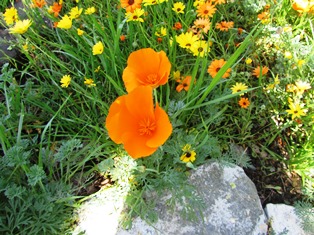Growing Wildflowers
You might call it serendipitous. Last weekend while Carlos and I replaced windows along the front of the house, my son went hiking in Marin with a cousin. While we trounced on the bed of wildflowers planted under the windows, my son was simultaneously picking wildflowers on his hike.
He brought home a fistful of lupines, poppies, California buttercups, heather, and wild mustard blooms.
It’s not a secret that Spring clothes Nature in her most majestic colors and patterns. I can just imagine the sight of those flowers filling a hillside. The moment I walk into my kitchen, my gaze is drawn to the intensity of lavender, blue, yellow, and orange blossoms adorning the my window.

The brilliant orange color of the California poppy is most dazzling when planted with purple lupines
For me, the sight of wildflowers growing on the sides of hills and mountains in Northern California seems to lighten my spirit and energize me. That’s a good reason, I figure, to grow them in beds at the entrance of our home. Their perkiness and bright colors welcome one and all.
When wildflowers are indigenous or have adapted to their habitats, they are often resistant to diseases and local pests. If you gather seeds from the wild, plant them soon after you harvest them. If they dry out, they enter dormancy (sleep) and may not not emerge from their dormant state.
Give wildflower seed the right soil–some will do well in rock gardens, but others want humus-rich soil. Take note of the soil where you found them growing in the wild. Woodland wildflowers will need more water than a desert plant, so take note of water needs and also the amount of sunlight exposure the plant might require.
Grow perennial wildflowers from cuttings or clump divisions.
If you buy wildflowers in containers or as bare-root plants, pay attention to the quality of the plant’s leaves, stems, and blooms. Avoid purchasing a plant that has bruised or broken stems, wilted or burnt leaves, or pot-bound.
If the plant takes an unrealistically long time to regenerate or propagate, you probably have purchased a plant that has been collected in the wild, not grown in a nursery. Give it the right conditions in which to grow and nurture it along with patience.
 Facebook
Facebook Goodreads
Goodreads LinkedIn
LinkedIn Meera Lester
Meera Lester Twitter
Twitter



